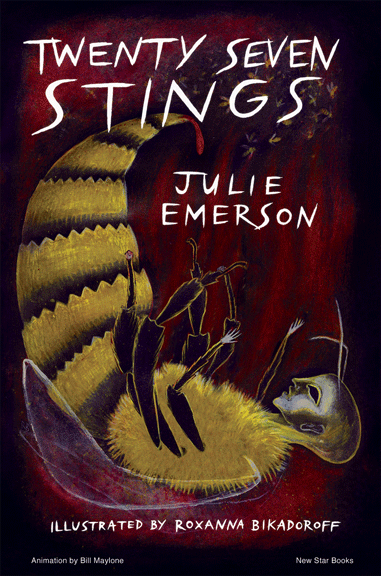
Twenty Seven Stings

Twenty Seven Stings is a book of poems inspired by the cultural histories and military strategies that have led us into wars throughout history, from sixth century China BCE to Alexander the Great to contemporary American drone warfare.
The title poem refers to the number of bee-stings required to kill an enemy, according to Pliny’s Natural History. Twenty Seven Stings engages with various aspects of war. These include the unsung roles of women as pawns or inspirations or lures; the rules of war; the elemental factors of season, landscape, and lack of food; and the use of poisons and bees as weapons. The book is dramatically illustrated by the reknowned illustrator Roxanna Bikadoroff.
published by New Star Books and available where books are sold https://www.newstarbooks.combook.php?book_id=155420107
from a 2016 Podcast Interview with the writer Julie Emerson and the illustrator Roxanna Bikadoroff:
Roxanna: There are some interesting women in Twenty Seven Stings, like the Poison Maiden...
Julie: Yes, the Poison Maiden was a girl in the 4th century BCE Nanda empire, who was given a toxin so her kiss would kill the enemy. Another woman in Alexander’s time was Thais. Thais was described as a beautiful courtesan, and she was blamed for speaking out, drunk, at a banquet and inciting the Greeks to burn down the Persian palace of Persepolis, which they’d just captured. There’s always been- as there still is - a conflicting impulse for the victors in war: do they destroy the other culture or do they claim its spoils and take it over? In this case, the historians writing about Persepolis blame it on the woman, Thais.
Roxanna: Do you consider landscape as crucial in Twenty Seven Stings?
Julie: Landscape is important to me, and important in war. In my poem about the Battle of Crecy, in August 1346, one line is: “dirt geometry clinches destiny”. Understanding the landscape is part of battle strategy. When and where is a good place to fight? King Edward of England could start the Hundred Years War on a weekend in August because he considered Crecy a perfect battle location with a wooded hill and a plain. But in any landscape there’s rain, cold, snow, and the fog of war - literally. In winter, what’s not growing in the landscape is food, so in the past, in China and in Russia, the enemy could use starvation as a strategy.
Roxanna: You write haiku, which is a minimalist type of poetry. The poems in this book are not haiku.
Julie: Ideally, a haiku is about one moment that is your sensory experience of the present. In Twenty Seven Stings, I wanted to explore historical situations which were very complex. I would research each culture and imagine myself in the situation. For example, I wrote about the first Marathon, 2500 years ago, when the Greeks did an epic walk from the beach of Marathon to try to get to Athens on foot before the Persians could sail there. I imagined myself in the mind of a Greek soldier. What would I be doing and eating and feeling? I’d be accompanied by my slave, of course, to carry my food and weapons, while we were both fighting, and then running to Athens – slaves were a third of the population of Athens, the cradle of democracy.
I used different poetic forms for the different settings. In one poem, I described Operation Quicksilver, which was a totally fake village around Dover that the British created in 1944. It was a deception to make the Germans think British soldiers were getting ready to attack Calais, so it was a fabricated world of dummy tanks, lights turning on and off, fake kitchens, and simulated military practice. One line in this poem is “They heard a life thick and luscious”, and I hope this can be said of the poems in Twenty Seven Stings.

